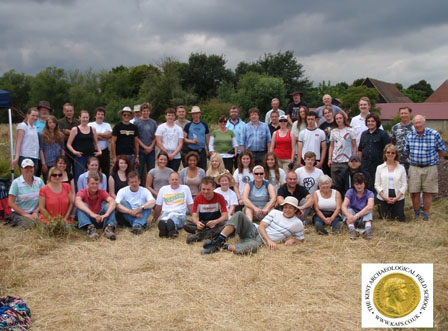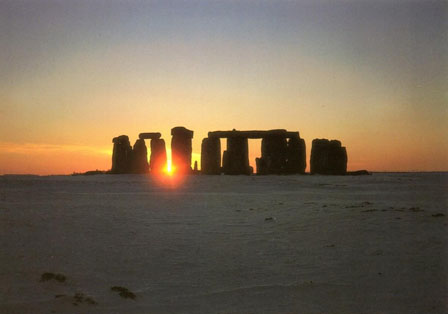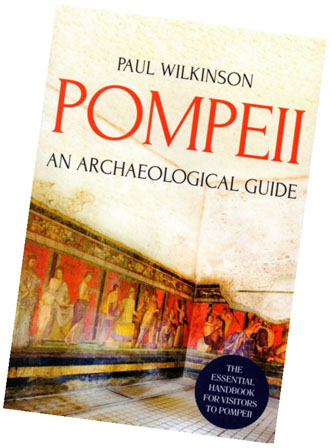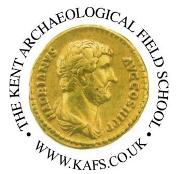 |
||||||

|

Breaking News: Christmas 20AD and 2024AD! 
It was a public holiday celebrated around December 25th in the family home. A time for feasting, goodwill, generosity to the poor, the exchange of gifts and the decoration of trees. But it wasn’t Christmas. This was Saturnalia, the pagan Roman winter solstice festival.
The KAFS year in 2024 was curtailed by the pandemic but we have spent the time in catching up on reports but look forward to greeting you in 2025 on site or courses- 
KAFS ‘dig’ at Abbey Barns at Faversham- can you name the year?
The report on the ‘henge’ at Harrietsham (right) is now also published




Must watch this Christmas! “Pompeii: The New Dig” on BBC 
It’s the return of “Pompeii: The New Dig”: New Documentary “Pompeii: The New Dig,” a riveting documentary series from the esteemed creators behind “Secrets of the Saqqara Tomb” and “Saving Venice,” offers an unprecedented look into the most comprehensive archaeological excavation in Pompeii of the current generation. Spanning nearly two years, this documentary provides exclusive access to a groundbreaking excavation and the dedicated all-Italian team of archaeologists at its helm. The series meticulously documents the excavation of an entire city block in Pompeii, revealing profound insights into the daily lives of its inhabitants before the catastrophic eruption of Mount Vesuvius in AD 79. 
One of the most astonishing discoveries highlighted in the documentary is the unearthing of a fresco resembling a pizza. This 2,000-year-old artwork was found in the Regio IX section of Pompeii’s archaeological park, close to Naples— the birthplace of pizza. The fresco, located on a wall that appears to have been part of a hallway in a house possibly linked to a bakery, offers a fascinating glimpse into the culinary practices of ancient Pompeii and suggests a cultural continuity that has persisted into modern times. 
The first episode of “Pompeii: The New Dig” captivates with its innovative approach to storytelling. The documentary employs illustrations reminiscent of ancient frescoes, adding a layer of authenticity and visual appeal that enriches the viewer’s experience. The inclusion of a diverse range of experts—from volcanologists to construction workers—provides a multidisciplinary perspective on the ancient city, illustrating the timelessness of certain trades and practices.
Christmas Gifts/Not too Late! Stuck for a Christmas Gift – and don’t leave it too late! Try www.danegeld.co.uk who make accurate historic jewellery (right) and include Celtic to Early Roman to Victorian to Art Deco at affordable prices...Everything from Roman pottery-Terra Sigillata to the Ancient Roman folding stool of Hadrian and all can be found at https://theancienthome.com/collections/roman-pottery-terra-sigillata  “Can I buy a present as it is Christmas”…What’s Christmas!!
However, inside Pilate's palace, the PFJ encounters another revolutionary group who had the same idea which sparks a violent argument. Brian is the sole survivor of the fight but is captured by the palace guards. The guards bring Brian before Pilate, but his questioning is cut short when the guards began uncontrollably laughing at the names of Pilate's friend from Rome Biggus Dickus and his wife Incontinentia Buttocks.
 And now for something different for this winter: ‘Beowulf in Kent’ by Paul Wilkinson Gary Budden writes: It’s a compelling thought; the monster Grendel inhabiting the bleak marshlands of the Isle of Harty (part of what we now call Sheppey), just over the water from the town of Faversham, separated from the mainland by The Swale. These islands tend to overfeed the imagination; lost tribes can dwell there, grisly remains, evolutionary dead ends, the sons of Cain. 
Sheppey, and the other small islands that appear as odd unmarked blanks of green on Google Maps, hold dark histories. Deadman’s Island and Burnt Wick Island, so close to home and practically unknown, are borderline inaccessible. They hold the mass graves of Napoleonic French prisoners who died on the prison hulks (you’ll know them from Great Expectations) and their bones now rise from the silt. Walk the Hollow Shore between Faversham and Whitstable, look out over to the island across the Swale, no one else around and the wind stinging the eyes. It’s easy to feel Anglo-Saxon in such a place.

The theory even goes as to suggest that Beowulf was buried under Nagden mound (a possible artificial hill that was destroyed in 1953 by men contracted to rebuild the sea wall between Faversham and Seasalter, after the great North Sea flood.), though by this point the theory has fallen more into wishful thinking and a lot of ‘maybes’ rather than anything that could approximate a credible argument. In my fictional landscape, Grendel and his mother fit in well with the bodies of those dead Frenchman, the prisons across the water on Sheppey, the bleak marshes, the boxing hares and the black curlews of my own fictions.

For TV clip see: Beowulf in Kent - YouTube BACK TO MENU A DAY OF PAGAN RITUALS by Paul Wilkinson
The Winter Solstice is the moment when the sun reaches its most southern point, after which days get longer again. It creates an alignment at Neolithic sites around the world, including Stonehenge, Newgrange in Ireland, and Iwade henge in Kent. Neo-druids, neo-pagans, and Wiccans - a variation on paganism - gather to chant spiritual mantras and bless the sun. Many of our traditional Christmas tokens, including the Yule log, mistletoe, and decorating evergreen trees, started as Winter Solstice rituals.

The solstice is traditionally celebrated at the sunrise closest to the time when the sun is stationary before beginning its transit to the north or south. This year this occurs at 23.03 GMT on Sunday 21 December, hence the winter solstice celebrations take place at sunrise on 22 December. The Winter Solstice was a time in prehistory when most cattle were slaughtered (so they would not have to be fed during the winter) and the majority of wine and beer was finally fermented. For us in Kent in the Northern Hemisphere, the December solstice marks the longest night and shortest day of the year. Meanwhile, on the day of the December solstice, the Southern Hemisphere has its longest day and shortest night.
It takes six months for the point of sunrise (setting) to move from one extreme to the other or twelve months to complete the full cycle. Notice that the direction of Summer solstice sunrise is opposite to the Winter solstice sunset and the Winter solstice sunrise is opposite to the Summer solstice sunset. The same principle applies throughout the year. Risings (settings) that occur either six months before or after a particular day, are opposite to the settings (risings). North of the Equator all heavenly bodies appear to move from left to right (clockwise). Given clear conditions, the apex of the rising sun suddenly appears on the horizon, almost like a car headlight coming into view over a hill-top. Slowly the full orb comes into view, which takes about four minutes. Meanwhile the sun will have moved nearly one degree to the right. When exact alignments are required, they are usually taken either on the point of first flash (or gleam) or at the point where the full orb appears tangent to the horizon. Setting phenomena of sun are in reverse order. The full orb first descends to the horizon and the point where it finally disappears is referred to as 'last light' (or gleam).

The word Solstice (Latin from sol, the sun and statum to stand still) denotes the time when the sunrise reaches its extreme positions, when it appears to remain static or stand still for several days. This made it difficult to know the exact day of the solstice, so prehistoric people marked the point of sunrise well before the solstice day, and then counted the number of days before it returned to the marked position. Half this number would define the Solstice day.
No matter where you live on Earth’s globe, a solstice is your signal to celebrate. For us in Kent on the northern part of Earth, the shortest day comes at the solstice which this year is Wednesday 21st December at 21.47. After the winter solstice, the days get longer, and the nights shorter. It’s a seasonal shift that nearly everyone notices. The universe holds its breath and when it breaths again we are in a new cycle of life. Dr Paul Wilkinson Books for Christmas / Archaeological Guide to Pompeii. Rating 5 Stars 
Author Paul Wilkinson and published by Taurus Books 1st Edition and Bloomsbury 2nd & 3rd Editions.


Courses at the Kent Archaeological Field School for 2025 will include:Field Walking and Map Analysis (Spring Bank Holiday Sat 19th April to Sunday 20th April) Field work at its most basic involves walking across the landscape recording features seen on the ground. On this weekend course we are concerned with recognising and recording artefacts found within the plough soil. These include flint tools, Roman building material, pottery, glass and metal artefacts. One of the uses of field walking is to build up a database for large-scale regional archaeological surveys. We will consider the importance of regressive map analysis as part of this procedure. The course will cover:

Photo 1. Snagbrook Farm ‘dig’ in July 2023 Snagbrook Roman Villa and Water mill Excavations and Training Course (Sat 19th-Friday25th July) KAFS will be returning to the Roman Villa complex at Snagbrook where we will continue with previous season work on planning, survey and archaeological investigations to clarify the function and extent of Roman buildings identified in archaeological excavations in 2023 by KAFS. In addition recent geophysical survey work by the Kent Archaeological Field School (KAFS) and Brook Archaeology has identified substantial and important Roman buildings and infrastructure to the west and north of the initial investigations of the KAFS in May 2023. Please note that the initial evaluation work is just the first stage of a phased programme of work and if archaeology is located the evaluation is Stage One and a Stage Two will be required of excavation/watching brief/preservation in situ which may be necessary. Stage Three will be post-excavation and publication. 
Photo 2. Geophysical survey by Brook Archaeology (above) has recognised buildings to the north-east of our 2023 archaeological investigations (purple rectangles) at Snagbrook, Hollingbourne.
Training Week (Monday 14h July) for Students on a Roman Villa and Water Mill at Hollingbourne in Kent It is essential that anyone thinking of digging on an archaeological site is trained in the procedures used in professional archaeology. Dr Paul Wilkinson, author of the bestselling "Archaeology" book and Director of SWAT Archaeology will spend seven days explaining to participants the methods used in modern archaeology. A typical training day will be classroom theory (on site) in the morning followed by excavations at the Roman water mill and villa at Hollingbourne in Kent.
A free PDF copy of "Archaeology" 4th Edition will be given to participants. Cost for the course is £100 if membership is taken out at the time of booking plus a Certificate of Attendance.  Thanks for reading the newsletter and supporting the Kent Archaeological Field School. Your donations and membership fees over the last two years have paid for the research and report writing which is essential to any archaeological investigations and all reports are available free on our website www.kafs.co.uk 

For all booking enquiries email
[email protected]
|
|||||
